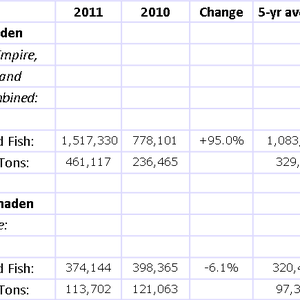The value of salmonids production increased by 13 per cent to $369.1 million in 2009–10, to surpass rock lobster as Australia’s highest earning fisheries product, according to Australian fisheries statistics 2010, released today by ABARES.
Australian salmonids production predominantly consists of trout and Atlantic salmon.
ABARES acting Deputy Executive Director, Terry Sheales, said the higher value for salmonids was underpinned by higher production in the aquaculture sector, more than 95 per cent of which is in Tasmania.
“Despite higher earnings from the production of salmonids and prawns, the gross value of Australian fisheries production fell by 2 per cent to $2.18 billion in 2009–10,” Dr Sheales said.
“This decrease was mainly a result of lower earnings from the wild-catch sector, which fell by 3 per cent, while earnings from aquaculture production remained roughly stable.
“Australian fisheries production, in volume terms, increased by 2 per cent in 2009–10, however lower export prices for many fisheries products resulted in the gross value of production falling in the year.”
Export earnings in 2009–10 were influenced by the appreciation of the Australian dollar against several major currencies – 18 per cent against the US dollar, and by 8 per cent against the Japanese yen – which resulted in Australian producers receiving a lower price for their exports.
In 2009–10, the value of Australian fisheries exports decreased by 18 per cent to $1.2 billion, with rock lobster the most valuable fisheries export in the year (valued at $400 million), followed by pearls ($244 million), abalone ($216 million), tuna ($118 million) and prawns ($61 million).
Hong Kong and Japan remained the main export markets for Australian fisheries exports in 2009–10, accounting for 55 per cent and 22 per cent in value terms, respectively.
Other major export markets include the United States (5 per cent), China (4 per cent) and Singapore (3 per cent).
The value of Australian imports of fisheries products declined by 11 per cent to $1.5 billion in 2009–10, which is mostly because of lower import values of pearls.
On releasing the report, Dr Sheales acknowledged the assistance and contribution of the Fisheries Research and Development Corporation to the report.
Australian Fisheries Statistics 2010
Australian Fisheries Statistics 2010 - PDF [1.9 MB]
Data
Australian Fisheries Statistics 2010 - Exports - MS Excel [0.3 MB]
Australian Fisheries Statistics 2010 - Imports - MS Excel [0.4 MB]
Australian Fisheries Statistics 2010 - Production - MS Excel [0.5 MB]
Australian Fisheries Statistics 2010 - Production (annual for 2000 - 2010) - MS Excel [0.7 MB]








